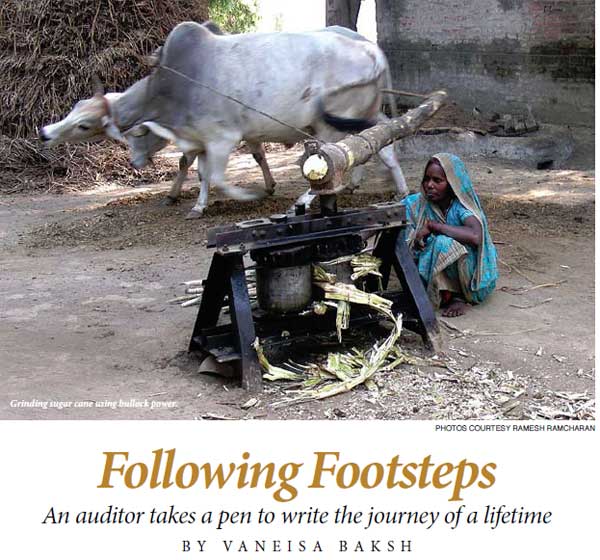 |
 |
 |
|
May 2012 |
The passion, which he invokes like a mantra, is for tracing his ancestral roots in India and bringing to life the images he had carefully husbanded from the stories told by his grandmother (Aaji) and the rich diet of Indian movies from his childhood. Both had created such a fairytale aura around India—film creating a landscape of beauty, song, and mystery, with his aaji’s stories pouring chunks of a different reality: poverty, hardship, and overcrowded communities—that he yearned to press the flesh of this familiar yet faraway land. So, Ramesh set off on his journey of discovery, visiting Jamaican archives to find documents, visiting India for more, and reconnecting with the family his grandparents—25 and 21 years old—had left behind when they set sail on the SS Indus on July 2, 1905 and landed in Jamaica on July 27.
It was a rural, agricultural life that was passed on. Ramesh noted that when he was growing up, “my parents were involved in gardening, planting and harvesting sugar cane and other agricultural crops.” His grandmother related stories of her life in India and Jamaica. “In 1923, she lost her husband, and all his relatives in Trinidad had already returned to India, she was in a totally strange place. Being a woman in this unfamiliar land, with three young children, no husband, no relatives, few new friends; with nothing like telephone, Internet, Skype, cell phone, e-mail, and as someone who could not read or write, she was virtually locked away in another corner of this world, and she had to move her life ahead.” He said she taught her children both Bhojpuri and English and passed on much of their oral history to his parents. For her to speak out as frankly as she did, in a time when women were not even allowed to address men by their ‘proper’ names (and were not even referred to by their first names, but by reference to their male kin, such as so-and-so’s daughter), was an act of bravery that made her assume heroic proportions in his mind. “In my eyes, she was a hero, the link that made it possible to connect the families on both side of the world,” he said. The book, according to the author’s preface, “follows three generations of an agricultural family, which originated from the remote farming community of Karaundi Goan near the town of Faizabad in the Indian state of Uttar Pradesh.”
It is not just a narrative, he says it contains a number of documents, like the ship’s manifest, which offers information on the 800 passengers such as their names, place of registration, father’s name, gender, caste, district, village and so on. He wanted others to have a chance to trace their own ancestral lines and so has even included a sort of how-to guide as to documents required (and where to get them) for anyone interested in setting off on a similar journey. He is very keen for readers to appreciate that the book is full of “primary” data and the “originality” of his sources. It is not an academic work, and he does not want it to be mistaken for such. It is different, because it tells the story of one family’s history from the magical land of India to the even more magical land of Trinidad. The book, “Where the Journey Began,” is available at the UWI Bookshop and other national booksellers. |

 He’s not a writer; really, his is the world of finance, which is what he practises as Campus Management Auditor at the St. Augustine Campus of The UWI. But Ramesh Ramcharan believes he was driven to write the book that was launched earlier this month, “Where the Journey Began,” because he chose to take a risk and be adventurous in pursuit of his passion.
He’s not a writer; really, his is the world of finance, which is what he practises as Campus Management Auditor at the St. Augustine Campus of The UWI. But Ramesh Ramcharan believes he was driven to write the book that was launched earlier this month, “Where the Journey Began,” because he chose to take a risk and be adventurous in pursuit of his passion. “My grandparents came from India to Jamaica then to Trinidad,” he explained. Indeed, Jagesar and Maharaji had thought they were coming to “Chinnidad,” but ended up at Newry Estate, where they lived and worked for some years before coming to Trinidad with their firstborn and making their home in Tacarigua.
“My grandparents came from India to Jamaica then to Trinidad,” he explained. Indeed, Jagesar and Maharaji had thought they were coming to “Chinnidad,” but ended up at Newry Estate, where they lived and worked for some years before coming to Trinidad with their firstborn and making their home in Tacarigua. 